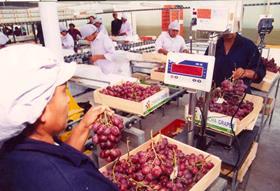
The earlier date of 31 January for Chinese New Year is proving to be something of a challenge, with growers and suppliers struggling to supply the early varieties that will be in demand for the festival.
'The 31st is a bit too early for imports,” said Rod Hill, general import manager at Golden Wing Mau. “Chile would always prefer a slightly later festival to maximise exports. It’d be better two weeks later.”
Hill added that this is particularly pronounced in regions where frost has damaged early production, such as Chile. As well as reducing its cherry crop by 50 per cent, the frosts have seen Chile’s stonefruit crop drop by 60-70 per cent, which Hill says is devastating for the industry. “We’ll probably see very limited stonefruit arrivals for Chinese New Year,” he said. “Financial losses in the stonefruit industry will be dramatic.”
US grapes have been experiencing a tough season due to high pricing and more local fruit available, according to Hill. However, market conditions are looking more favourable ahead of the festival. “Domestic production has made the season difficult to date, but it is almost finished and prices are stabilising,” he said. “It should be positive for US exporters in the lead up to Chinese New Year.”
Peru is also set for a potentially difficult Chinese New Year, despite efforts to increase production in the country’s northern region. “While production there is increasing and there’s more fruit available, it’s a bit dark this year, which makes it not best suited for Chinese consumers,” explained Hill. “I’m not sure whether we will see increased export volumes or not.”
Bosch agrees, elaborating on the strong consumer fixation with fruit’s aesthetic appeal. “The market is still very much focused on the visual appeal and scarcity of fruit making it more a status symbol than a healthy food seen in every household to be eaten and enjoyed daily,” he said. “This is particularly pronounced at New Year, when fruit is given as a gift.
“Peruvian Grapes are always good performers but the early Peruvian volumes seem to struggle to get the red coloration that the market demands. The early fruit tends to be dark in colour and making good returns on darker fruit is very difficult.”
As well as colour issues in the north, key growing areas in southern Peru are coming into production a bit late, according to Hill. “Exporters will struggle to get decent volumes in ahead of New Year.”



